Students can Download Accountancy Chapter 12 Final Accounts of Sole Proprietors – I Questions and Answers, Notes Pdf, Samacheer Kalvi 11th Accountancy Book Solutions Guide Pdf helps you to revise the complete Tamilnadu State Board New Syllabus and score more marks in your examinations.
Tamilnadu Samacheer Kalvi 11th Accountancy Solutions Chapter 12 Final Accounts of Sole Proprietors – I
Samacheer Kalvi 11th Accountancy Final Accounts of Sole Proprietors – I Text Book Back Questions and Answers
I. Multiple Choice Questions
Choose the Correct Answer
Question 1.
Closing stock is an item of ……………..
(a) Fixed asset
(b) Current asset
(c) Fictitious asset
(d) Intangible asset
Answer:
(b) Current asset
Question 2.
Balance sheet is ……………..
(a) An account
(b) A statement
(c) Neither a statement nor an account
(d) None of the above
Answer:
(b) A statement
Question 3.
Net profit of the business increases the ……………..
(a) Drawings
(b) Receivables
(c) Debts
(d) Capital
Answer:
(d) Capital
![]()
Question 4.
Carriage inwards will be shown ……………..
(a) In the trading account
(b) In the profit and loss account
(c) On the liabilities side
(d) On the assets side
Answer:
(a) In the trading account
Question 5.
Bank overdraft should be shown ……………..
(a) In the trading account
(b) Profit and loss account
(c) On the liabilities side
(d) On the assets side
Answer:
(c) On the liabilities side
Question 6.
Balance sheet shows the …………….. of the business.
(a) Profitability
(b) Financial position
(c) Sales
(d) Purchases
Answer:
(b) Financial position
Question 7.
Drawings appearing in the trial balance is ……………..
(a) Added to the purchases
(b) Subtracted from the purchases
(c) Added to the capital
(d) Subtracted from the capital
Answer:
(d) Subtracted from the capital
Question 8.
Salaries appearing ill the trial balance is shown on the ……………..
(a) Debit side of trading account
(b) Debit side of profit and loss account
(c) Liabilities side of the balance sheet
(d) Assets side of the balance sheet
Answer:
(b) Debit side of profit and loss account
![]()
Question 9.
Current assets does not include ……………..
(a) Cash
(b) Stock
(c) Furniture
(d) Prepaid expenses
Answer:
(c) Furniture
Question 10.
Goodwill is classified as ……………..
(a) A current asset
(b) A liquid asset
(c) A tangible asset
(d) An intangible asset
Answer:
(d) An intangible asset
II. Very Short Answer Questions
Question 1.
Write a note on trading account.
Answer:
Trading refers to buying and selling of goods with the intention of making profit. The trading account is a nominal account which shows the result of buying and selling of goods for an accounting period. Trading account is prepared to find out the difference between the revenue from sales and cost of goods sold.
Question 2.
What are wasting assets?
Answer:
These are the assets which get exhausted gradually in the process of excavation. Examples: mines and quarry.
Question 3.
What are fixed assets?
Answer:
Fixed assets are those assets which are acquired or constructed for continued use in the business and last for many years such as land and building, plant and machinery, motor vehicles, furniture, etc.
![]()
Question 4.
What is meant by purchases returns?
Answer:
Goods purchased which are returned to suppliers are termed as purchases returns or returns outward.
Question 5.
Name any two direct expenses and indirect expenses.
Answer:
Direct expenses:
- Carriage inwards or freight inwards
- Wages Indirect expenses:
Indirect expenses:
- Office and administrative expenses
- Selling and distribution expenses
Question 6.
Mention any two differences between trial balance and balance sheet.
Answer:
| S.No. | Basis | Trial Balance | Balance Sheet |
| 1. | Nature | Trial balance is a list of ledger balances on a particular date. | Balance sheet is a statement showing the position of assets and liabilities on a particular date. |
| 2. | Purpose | Trial balance is prepared to check the arithmetical accuracy of the accounting entries made. | Balance sheet is prepared to ascertain the financial position of a business. |
Question 7.
What are the objectives of preparing trading account?
Answer:
- Provides information about gross profit or gross loss.
- Provides an opportunity to safeguard against possible losses.
Question 8.
What is the need for preparing profit and loss account?
Answer:
- Ascertainment of net profit or net loss
- Comparison of profit
- Control on expenses
- Helpful in the preparation of balance sheet.
III. Short Answer Questions
Question 1.
What are final accounts? What are its constituents?
Answer:
Businessmen want to know the profitability and the financial position of the business. These can be ascertained by preparing the final accounts or financial statements. The final accounts or financial statements include the following:
- Income statement or trading and profit and loss account; and
- Position statement or Balance sheet.
![]()
Question 2.
What is meant by closing entries? Why are they passed?
Answer:
Balances of all the nominal accounts are required to be closed on the last day of the accounting year to facilitate the preparation of trading and profit and loss account. It is done by passing necessary closing entries in the journal proper. Purchases has debit balance and purchases returns has credit balance. At the end of the accounting year, the balance in purchases returns account is closed by transferring to purchase account.
Question 3.
What is meant by gross profit and net profit?
Answer:
- If the amount of sales exceeds the cost of goods sold, the difference is gross profit.
Sales – Cost of goods sold = Gross profit. - If the total of the credit side of the profit and loss account exceeds the debit side, the difference is termed as net profit.
Question 4.
“Balance sheet is not an account” – Explain.
Answer:
A balance sheet is a part of the final accounts. However, the balance sheet is a statement and not an account. It has no debit or credit sides and as such the words ‘To’ and ‘By’ are not used before the names of the accounts shown therein.
Question 5.
What are the advantages of preparing a balance sheet?
Answer:
Balance sheet discloses the financial position of a business on a particular date, it gives
the balances only for the date on which it is prepared. It shows the financial position of the business according to the going concern concept.
![]()
Question 6.
What is meant by grouping and marshalling of assets and liabilities?
Answer:
1. The term ‘grouping’ means showing the items of similar nature under a common heading. For example, the amount due from various customers will be shown under the head‘sundry debtors’.
2. ‘Marshalling’ is the arrangement of various assets and liabilities in a proper order. Marshalling can be made in one of the following two ways:
- In the order of liquidity
- In the order of permanence
IV. Exercises
Question 1.
Prepare trading account in the books of Sivashankar from the following figures:

Answer:
Trading account of Sivashankar

Question 2.
Prepare trading account in the books of Mr. Sanj ay for the year ended 31st December 2017:

Answer:
Trading account of Mr. Sanjay for the year ended 31st December, 2017

Question 3.
Prepare trading account in the books of Mr. Sanj ay for the year ended 31st December 2017:

Answer:
Trading account of Saravanan for the year ended 31st December, 2017

Question 4.
From the following details for the year ended 31st March, 2018, prepare trading account

Answer:
Trading account for the year ended 31st March, 2018
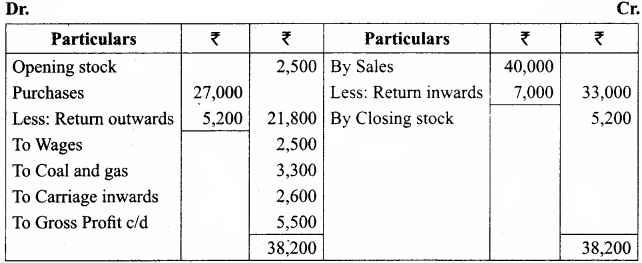
Question 5.
Ascertain gross profit or gross loss from the following:

Answer:
Profit and Loss Account

Question 6.
From the following balances taken from the books of Victor, prepare trading account for the year ended December 31,2017:

Answer:
Trading Account of Victor for the year ended 31st December, 2017
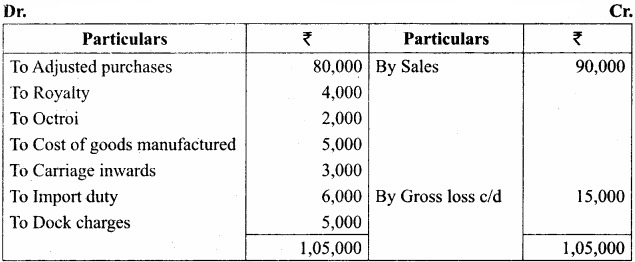
Hint : Closing stock will not appear in trading account because of adjusted purchases have been given.
Question 7.
Compute cost of goods sold from the following information:

Answer:
Cost of goods sold = Opening stock + Net purchases + Direct expenses – Closing stock
= 10,000 + 80,000 + 7,000 – 15,000
= ₹ 82,000
Note: Indirect expenses do not form part of cost of goods sold.
Question 8.
Find out the amount of sales from the following information:

Answer:
Cost of goods sold = Opening stock + Net purchases + Direct expenses – Closing stock
= 30,000 + 2,00,000 + 0 – 20,000
= ₹ 2,10,000

Therefore, percentage of gross profit on cost of goods sold is
\(\frac { 30 }{ 70 }\) x 100 = 42.85% (42.857142 ……….)
Gross profit = 42.85% on 2,10,000 i.e., \(\frac { 42.85 }{ 100 }\) x 2,10,000 = ₹ 90,000
Sales = Cost of goods sold + Gross Profit
= 2,10,000 + 90,000 (Fractions to be rounded)
= ₹ 3,00,000
Question 9.
Prepare profit and loss account in the books of Kirubavathi for the year ended 31st December, 2016 from the following information:

Answer:
Profit and loss account of Kirubavathi for the year ended 31st Dec, 2016

Question 10.
Ascertain net profit or net loss from the following:

Answer:
Profit and loss account

Question 11.
From the following details, prepare profit and loss account.

Answer:
Profit and loss account
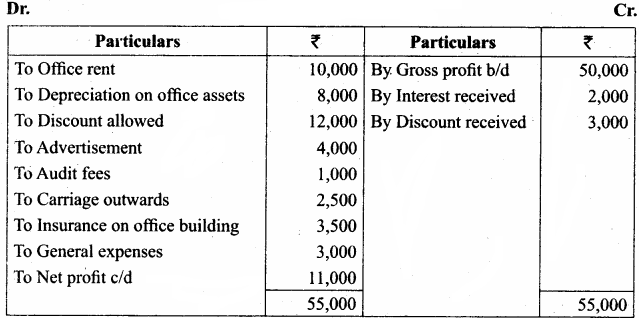
(Hint: Freight inwards will not appear in profit and loss account as it is a direct expense)
Question 12.
From the following information, prepare profit and loss account for the year ending 31st December, 2016.

Answer:
Profit and loss account for the year ended 31st December, 2016
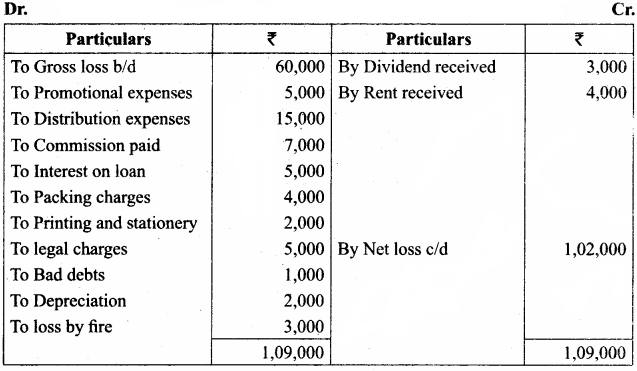
Question 13.
From the following balances obtained from the books of Mr. Ganesh, prepare trading and profit and loss account:

Answer:
Trading and Profit & loss account of Mr. Ganesh
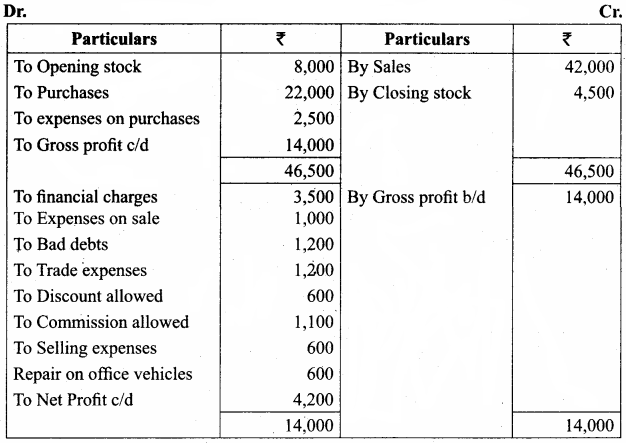
Question 14.
From the following balances extracted from the books of a trader, ascertain gross profit and net profit for the year ended March 31,2017:
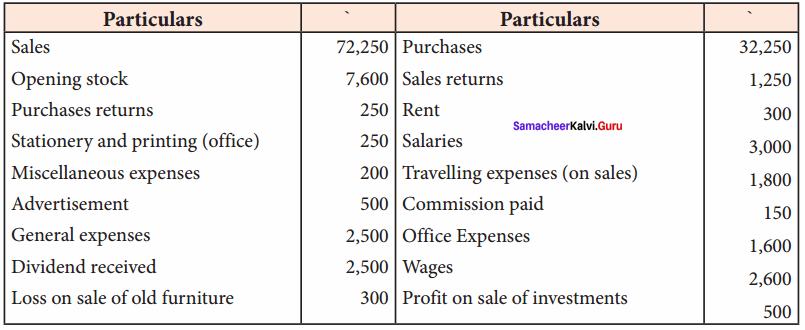
Answer:
Trading and Profit & Loss account for the year ended 31st March, 2017
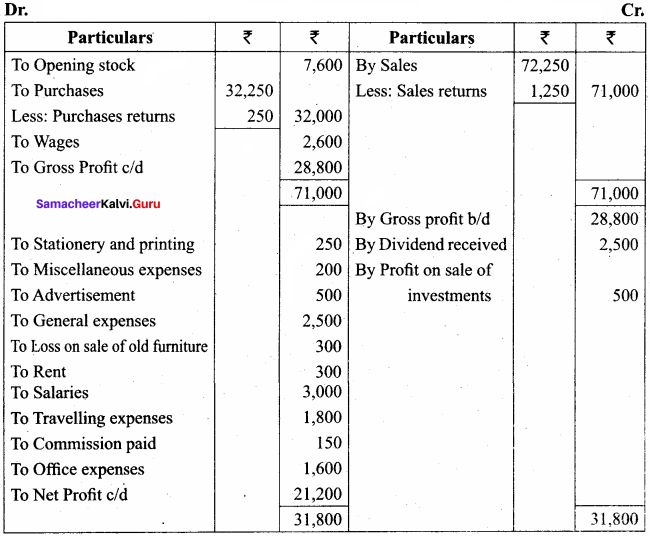
Question 15.
From the following particulars, prepare balance sheet in the books of Bragathish as on 31st December, 2017:

Answer:
Balance Sheet of Bragathish as on 31st December, 2017

Question 16.
Prepare trading and profit and loss account in the books of Ramasundari for the year ended 31st December, 2017 and balance sheet as on that date from the following information:

Answer:
Trading and Profit & Loss a/c of Ramasundari for the year ended 31 Dec, 2017 Cr.
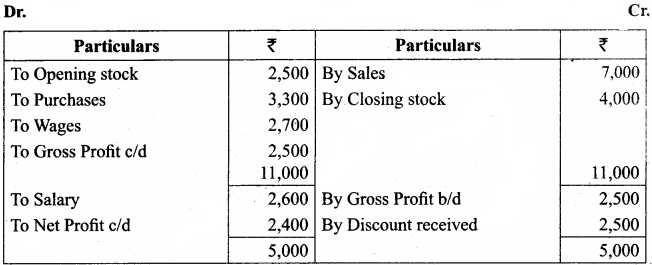
Balance Sheet of Ramasundari as on 31st March, 2018

Question 17.
From the Trial balance, given by Saif, prepare final accounts for the year ended 31st March, 2018 in his books:
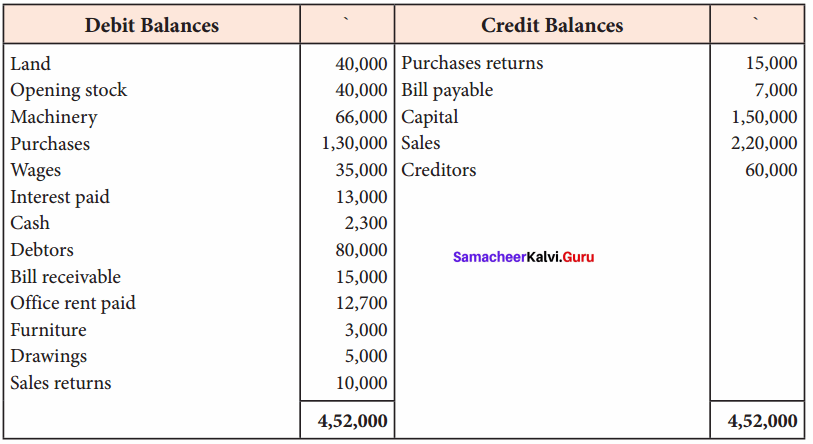
Answer:
Trading and Profit & Loss a/c of Saif for the year ended 31 March, 2018
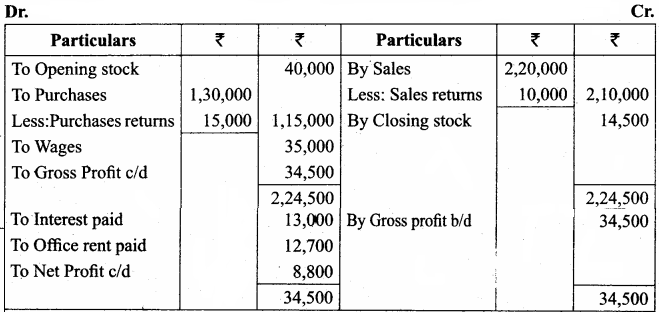
Balance Sheet of Saif as on 31st March, 2018
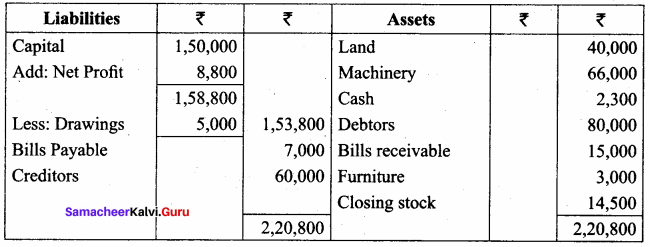
Question 18.
Prepare trading and profit and loss account and balance sheet in the books of Deri, a trader, from the following balances as on March 31, 2018.
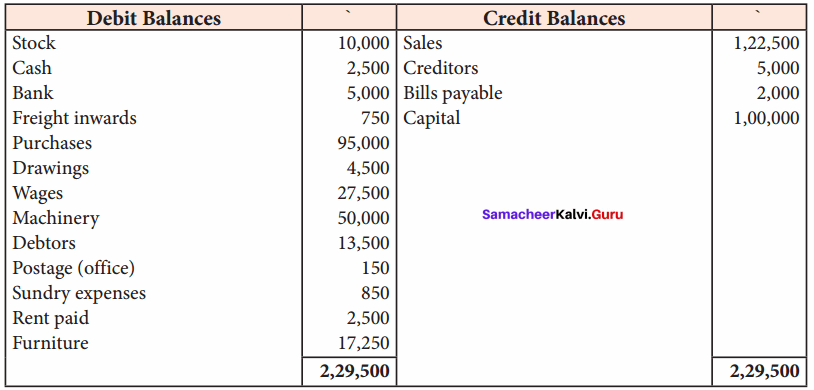
Answer:
Trading and Profit & Loss a/c of Deri for the year ended 31st March, 2018

Balance Sheet of Deri as on 31st March, 2018

Textbook Case Study Solved
Question 1.
Mr. Abhinav started a small shop of selling dairy products. He wanted to maintain proper books of accounts. But, he had very little knowledge of accounting. He maintained only three books – purchases, sales and cash book by himself. He bought some dairy products and a refrigerator to store the milk products for which the payment was made by cheque but recorded the same in the purchases book. He also spent for the transportation charges and paid some money to the person who unloaded the stock. He recorded the same in the cash book.
He made both cash and credit sale for the next few weeks. He entered the entire sales in the sales book. In the middle of the month, he was in need of some money for his personal use. So he took some money, but did not record in the books.
Now, discuss on the following points:
Question 1.
Do you think Mr. Abhinav needs an accountant? Why do you think so?
Answer:
Yes, Mr. Abhinav needs an accountant because he records all cash and credit transactions.
Question 2.
Does he maintain enough books of accounts?
Answer:
Yes, he maintains enough books of accounts.
![]()
Question 3.
What other books do you think that he needs to maintain?
Answer:
He needs to maintain a petty cashbook.
Question 4.
What will be the impact on the profit, if he records the purchase of refrigerator in the purchases book?
Answer:
The purchase book will be overcast because this transaction will be recorded in proper journal.
Question 5.
Is it important to record the money taken for personal use? Will it affect the final accounts?
Answer:
Yes, then only the actual profit or loss can be found out in the business.
Question 6.
Identify some of the accounting principles relevant to this situation.
Answer:
Some of the accounting principles relevant to this situation are: matching principles, business entity concept, money measurement concept, dual output concept, periodicity concept and going concern concept.
Samacheer Kalvi 11th Accountancy Final Accounts of Sole Proprietors – I Additional Questions and Answers
I. Multiple Choice Questions
Choose the correct answer
Question 1.
Income statement is divided into ……………….. parts.
(a) one
(b) two
(c) three
(d) four
Answer:
(b) two
Question 2.
The first part of the income statement is ………………..
(a) Final account
(b) Trading account
(c) Profit and Loss account
(d) Balance Sheet
Answer:
(b) Trading account
![]()
Question 3.
Balances of all ……………….. accounts are required to be closed on the last day of the accounting year.
(a) Nominal
(b) Personal
(c) Real
(d) Representative personal
Answer:
(a) Nominal
Question 4.
Trading account is a ……………….. account.
(a) Personal
(b) Nominal
(c) Real
(d) Representative personal
Answer:
(b) Nominal
Question 5.
Sales – Gross Profit = ………………..
(a) Sales
(b) Cost of goods sold
(c) Gross profit
(d) Gross loss
Answer:
(b) Cost of goods sold
Question 6.
……………….. account is the second part of income statement.
(a) Trading
(b) Profit and Loss
(c) Balance sheet
(d) Final
Answer:
(b) Profit and Loss
Question 7.
Which one is correctly matched?
(a) Bad debts – Indirect expense
(b) Wages – Asset
(c) Salary – Trading account
(d) Net Profit – Asset
Answer:
(a) Bad debts – Indirect expense
![]()
Question 8.
Balances of all the personal and real account are shown in ………………..
(a) Trading account
(b) Profit and loss account
(c) Income statement
(d) Balance sheet
Answer:
(d) Balance sheet
Question 9.
A balance sheet is a part of the ……………….. account.
(a) Trading
(b) Profit and Loss
(c) Income statement
(d) Final
Answer:
(d) Final
Question 10.
……………….. is a summary of the personal and real accounts.
(a) Balance sheet
(b) Final account
(c) Trading account
(d) Profit and loss account
Answer:
(a) Balance sheet
Question 11.
The balance sheet of business concern can be presented in the ……………….. forms.
(a) two
(b) three
(c) four
(d) six
Answer:
(a) two
Question 12.
Marshalling can be made in one of the ……………….. ways.
(a) three
(b) two
(c) four
(d) five
Answer:
(b) two
Question 13.
These are the assets which get exhausted gradually in the process of excavation.
(a) Wasting assets
(b) Nominal assets
(c) Liquid assets
(d) Current assets
Answer:
(a) Wasting assets
Question 14.
……………….. liabilities are not shown in the balance sheet.
(a) Contingent
(b) Current
(c) Liquid
(d) Fixed
Answer:
(a) Contingent